Finding an old phone in a drawer and turning it on to see if it still works is one of life’s great pleasures (we never said we’re exciting folk here at TechRadar).
But if said phone is a BlackBerry, save yourself the trouble - it stopped working as of January 4 . BlackBerry hasn’t made a new non-Android phone since 2016. It hasn’t released an operating system in even longer. And now it’s turned the service off, meaning no phone calls, no emails, no messages... nada.
In fairness, the majority of BB owners have migrated to iOS or Android over the years - with the absence of Windows Phone as well, it’s a fairly binary choice these days.
Even diehard BlackBerry fans who wanted mod cons had to migrate to Android: in latter years, a licensing deal with China’s TCL kept the brand name alive with Google’s OS powering the backend.
But now, the life support machine’s been switched off and legacy BlackBerry devices will “no longer function reliably,” says BlackBerry. So let’s be nostalgic for a minute and look at five things BlackBerry got fantastically right - and five things it got badly wrong.
5 things BlackBerry phones got right
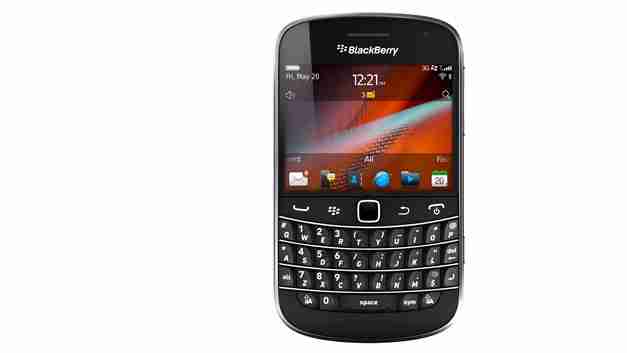
1. The ‘Look At Me’ light
Sometimes, the smallest things have the biggest impact. This was never truer than the blinking notification light - something we hanker after even today. Android phones might serve up an always-on display, but nothing comes close in our retro rose-tinted eyes.
Ignore it? Not a chance. You couldn’t unsee it. The itch that had to be scratched. Who wanted us? Was it important? Only one way to find out..
Flashing green meant ‘relax - you’re online’, blue for Bluetooth (obviously) or red to say “Oi!”.
And you could customize it, too. In the days when anything beyond a polyphonic ringtone was a luxury, this was the gold standard in personalization.
2. The best keyboard
“They all have these keyboards that are there whether you need them or not,” spouted Apple’s seer as he unveiled the iPhone, bashed competitors and pounded the first nail into BlackBerry’s metaphorical coffin. “How do you solve this?”
Key point: BlackBerry users didn’t want this solved.
The keys were tactile with a satisfactory click. Small, but not too small. We could use one hand or two and they always seemed to know what we wanted to say. Even in later years, after flirting and failing with touchscreens, the keyboard came back to BlackBerry because it was what the users wanted. Welcome back, old friend.
Other devices tried - Motorola’s Q had a go, HTC’s ill-fated Facebook ChaCha phone and a few others too. But they were always poor imitations. Rumor had it that the keys resembled Blackberry seeds - hence the company’s name. And once some had a sweet taste of this fruit, they found it hard to give up.
3. On message
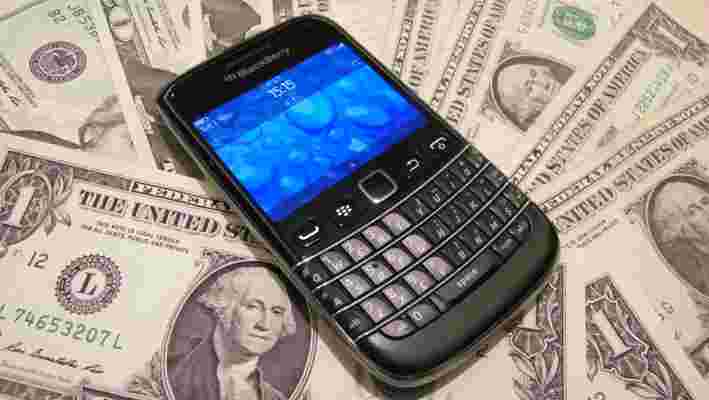
A proprietary message service to lock users in. Where’ve we heard that before? No Apple, you’re off the hook. Because RIM got here first.
For many of us, BBM was the reason to get a BlackBerry. A locked down ultra-secure messaging service that allowed users to DM friends or groups and send files securely. Business users loved it - teens and millennials, even more. Suddenly, ‘what’s your PIN’ was the teenage greeting of choice from people other than just muggers.
And if you didn’t get a reply to your message instantly, you could PING (basically annoy the person who was ignoring you with the digital equivalent of continuously poking them in the face.)
But time waits for no man. BlackBerry’s refusal to open up to other platforms ultimately helped move it into irrelevance. With cross platform options like WhatsApp on the scene, by the time BBM had decided to make itself available elsewhere, it was too late. There’s a lesson there: Don’t hang about.
4. Case in point
These days, you’re lucky to get a charger in the box with your smartphone. For all of the company’s corporate faults, generosity wasn’t one.
Unboxing gave us a treasure trove of goodies: from a classy leather holster engraved with the BlackBerry logo to a belt clip (because noughties) to some of the more mundane extras like a sync cable and CD Rom.
Some markets really pushed the metaphorical boat out - including an official chrome RIM charging stand and a polishing cloth.
BlackBerries were premium devices and they cost a pretty penny by the standards of the day. There wasn’t an expectation that customers should be nickel-and-dimed on top. 2022’s market could learn a thing or two.
5. Maximum exposure
There are some things money just can’t buy: eternal life, true love, real class. And an endorsement from Oprah. One of the world’s richest stars, she doesn’t say she likes something unless she wants to.
And she couldn’t shut up about her BlackBerry.
In fact, Oprah included the BlackBerry 7105T as one of her 2005 ‘favorite things’ in the bag of goodies given to her audience as part of the annual Thanksgiving show. Some CEOs would sell a kidney for this exposure.
It was arguably the start of RIM (BlackBerry’s parent company) catapulting from corporate to consumer in a big way, with RIM devices appearing in the hands of everyone from Kim Kardashian to President Obama (who had to have a custom ultra-secure version designed.). Not to mention demand among Joe and Jane Public.
This was before the days of the ‘gram, before influencing as we know it - and BlackBerry landed the biggest influencer of them all - on primetime US TV.
5 things BlackBerry phones got wrong
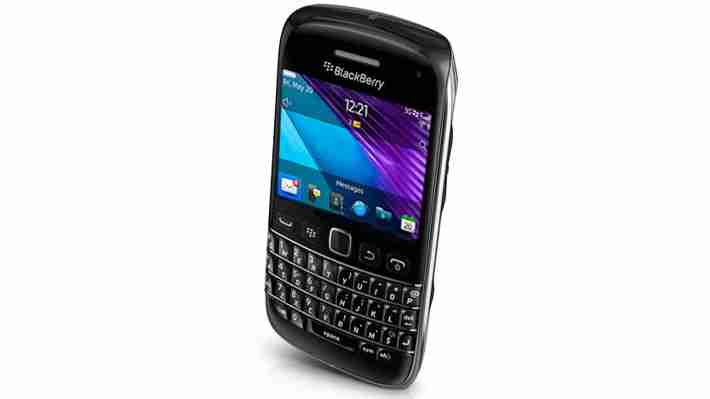
1. App-solutely woeful
BlackBerry App World was the wettest and most feeble app store you could get on a phone. What a letdown.
Ironically, BlackBerries had always been open - allowing external apps to be installed with relative ease. But Apple and Android gave us curated, managed storefronts. RIM followed and failed, breaking our hearts in the process.
Some apps - like Screen Muncher (a fun screenshot app and a particular favorite of ours) - gave the BlackBerry extra functionality. But it was like wading through the dregs of a dirty river to find a diamond - and not even coming across a bit of shiny plastic.
Even then, as we wrote , apps sell phones as much as phones do. You lose the developers, you lose the market. It wasn’t worth the devs’ time - and it wasn’t worth ours either.
2. Touch traumas
It’s not the winning, it’s the taking part that counts, right? Wrong. If you don’t have a good idea - stay away. But hindsight’s a wonderful thing.
With mounting pressure from the sales of the iPhone hitting the powerful carriers in the US (these were the days when the iPhone was exclusive to Cingular, now AT&T), Verizon was putting pressure on BlackBerry to come up with a competitor.
If in doubt, just say no. BlackBerry’s response: “Sure, here’s the Storm.” And never was a phone’s name more appropriate. We hate to say it was one of the worst phones ever. But it was one of the worst phones ever.
The idea was simple - a slab, like the iPhone. But created in a rush and with a fraction of the R&D investment. The keyboard BlackBerry users loved was gone and replaced with an on-screen version which required the whole screen to be pressed in for every touch. Yep, it was as painful as it sounded.
It was a disaster from a user interface perspective, and a disaster for RIM’s bottom line when the phones started breaking in their thousands and Verizon demanded RIM pay to repair them.
An ill-fated Storm 2 followed, but that didn’t right this wrong, and BlackBerry’s subsequent foray into the tablet space with the PlayBook appeared to make things worse. Launching a device that initially couldn’t run BlackBerry staples like email, contacts and calendar properly without an accompanying BlackBerry phone was a universe away from the all-in-one convenience of the iPad, which was well established by then. To many, it cemented the notion in their minds that RIM had lost the plot.
3. Crack attack
BlackBerries were fun - but they were also addictive. The term ‘Crackberry’ was coined as a joke term, the implication being that these devices got users hooked like a Class A drug. But the compulsion was real for so many. They just couldn’t put them down.
In fairness, before the BlackBerry came along, all phones could really do was play Snake and send an SMS. Creating a ringtone by methodically typing in a bunch of numbers didn’t elicit a dopamine response in the brain like getting an instant reply to your email, which you’d incredibly been able to send while riding on the bus.
So it wouldn’t be fair to put all the blame at RIM’s feet here. We got something new and exciting and we loved it. But users could barely switch off. And that lure of the flashing red notification light fueled that desire to constantly check notifications - something that’s prevalent even today with both iOS and Android giving options and tips on how to reduce screen time. The legacy of the Crackberry lives on, if not for the right reasons.
4. Arrogance
Pride comes before the fall, as they say. And BlackBerry learned this the hard way. To stay on top, you can’t stand still but RIM found itself doing just that.
When the iPhone launched, it couldn’t give us push email (it couldn’t even give us copy and paste!). The thought of Microsoft-powered Exchange servers (favorites of the corporate world) accessible on an iOS device was unthinkable. There were no outside apps, whereas BlackBerry allowed users to install programs downloaded from the web with ease. And the keyboard looked way harder to use than the tried-and-tested-and-loved BlackBerry board.
“We’ll be fine,” co-boss Mike Lazaridis reportedly said at the time. Famous last words. Apple and Google were nipping at BlackBerry’s heels by that point.
And as soon as Steve Jobs opened the iPhone up to outside developers and other networks, it was the beginning of the end for BlackBerry. Devs could make actual money for a device the world wanted. Nobody was interested in writing for BlackBerry and its dwindling user base. BlackBerry’s days were numbered.
5. Down and out
Late 2011 was when BlackBerry owners saw their collective anxiety hit an all-time high. At first, a few users started noticing their devices weren’t connecting. And within minutes, millions more weren’t.
BlackBerry’s servers were down. And with them, tens of millions of devices around the world.
Remember, these were devices used by multibillion dollar businesses that suddenly found hundreds or even thousands of staff members unable to connect.
RIM ran its own service - that’s what made BlackBerries so secure and almost independent of the phone networks. But it meant when things went bad, it was on its own. There was no external backup system to switch to. Users had to sit tight; RIM had to figure out the problem as more and more delayed data hit the network and created a massive backlog.
The blame was laid on what HQ called a ‘core switch failure’ - but even after the lights came back on, the exodus had begun. Co-boss Mike Lazaridis publicly apologized but the share price didn’t recover. iPhones - which had been gaining more traction - were looking more attractive to both IT departments and consumers. BlackBerry was a dead man walking. It would limp on for a few more years and the brand would continue under new owners. But the mass love for these little devices was gone. And BlackBerry would never recover.
Godzilla is getting an Apple TV show set in the Monsterverse
Spoilers follow for Godzilla vs Kong.
Godzilla fans, rejoice: a live-action TV series, set in Legendary Pictures' Monsterverse, is in development for Apple TV Plus.
Announced in a press release, the untitled TV show will exclusively launch on Apple's streaming service on a yet-to-be-revealed release date. Few details have been revealed about the show, so it seems that Godzilla's next small screen adventure is still in early development.
Interestingly, though, the head writer on a beloved Marvel comic series run will serve as a co-creator and executive producer on the series. Matt Fraction, the award-winning writer whose iconic Hawkeye comics were a chief influence on the superhero's recent Disney Plus series, will work with Chris Black (Star Trek: Enterprise, Desperate Housewives) to bring the show to life.
Black will act as showrunner, with the series being produced by Legendary Television alongside Safehouse Pictures and Toho, the studio behind Godzilla's creation in 1954. Toho's Hiro Matsuoka and Takemasa Arita will also serve as executive producers.
Per Apple's press release, the Godzilla live-action series will follow one family's journey to unearth a secret legacy that ties them to Monarch, the classified organization that tracks Godzilla and other Titans in Legendary's Monsterverse.
The announcement goes on to read: "Following the thunderous battle between Godzilla and the Titans that leveled San Francisco", which suggests that Apple's Godzilla TV show will take place after Godzilla, the first entry in the Monsterverse that was released in 2014.
If it does, that'll make it a pre-sequel series, which will sit between Godzilla and 2017's Godzilla: King of the Monsters. We've reached out to Apple for confirmation and will update this article if we hear back.
Godzilla was last seen in 2021 Monsterverse movie Godzilla vs Kong , the duo eventually teaming up to defeat Mechagodzilla before going their separate ways. It's unclear if previous Monsterverse actors, such as Ken Watanabe, will appear, or if this show will replace the rumored Son of Kong movie that was said to be in development with Godzilla vs Kong director Adam Wingard.
Analysis: Godzilla on TV? It's more common than you think
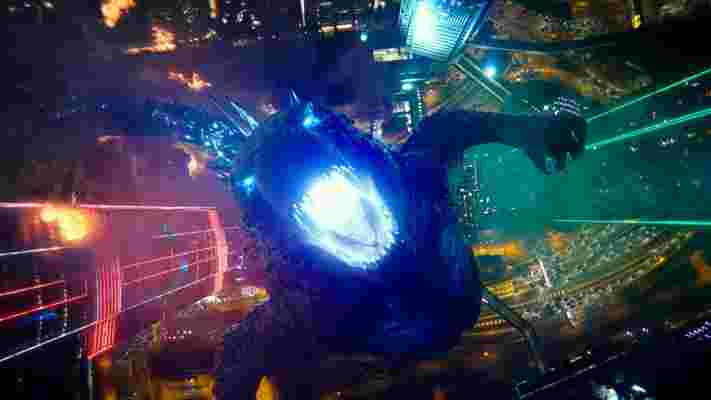
On the surface, a Godzilla TV show may sound like an odd move. After all, the iconic kaiju is renowned for appearing in plenty of movies – Japanese and English-language films – throughout its near 70-year history.
But Apple's live-action series won't be the first Godzilla project to land on the small screen – far from it, in fact. For one, Godzilla has appeared in numerous Toho TV productions, including Adventure! Godzillaland, Zone Fighter, and Godzilla Island.
Meanwhile, in western markets, a Hanna-Barbera developed Godzilla cartoon ran for 26 episodes on NBC from 1978 to 1979. Godzilla: The Series – which aired on Fox Kids between 1998 and 2000 – was a cartoon sequel to the much maligned 1997 Godzilla movie starring Matthew Broderick.
In recent years, various Godzilla anime shows and movies have landed on both sides of the Pacific Ocean. That number includes 2021's Godzilla Singular Point, a Bones and Orange anime-style production that aired on Tokyo MX in Japan and Netflix in other territories.
So, while Godzilla is most famous for its movie back catalog, the prehistoric sea monster has also starred in multiple TV projects down the years. Apple's live-action series, then, won't be an outlier among numerous Godzilla films – it'll actually just be the latest entry in a long line of TV shows with the legendary kaiju as its lead. And, given that we thought that Godzilla vs Kong should act as the launch pad for new Monsterverse stories , we're delighted to hear that a new Godzilla show is on the way.
The Witcher: Blood Origin: everything we know so far
The Witcher: Blood Origin could be the perfect tonic to those post-Witcher season 2 blues.
The second instalment in the Henry Cavill-starring hit Netflix show didn't exactly enamour itself to every Witcher fan, what with the creative choices made by its main players. We enjoyed The Witcher season 2 , for what it's worth, but we understand the frustration that some viewers had towards the TV adaptation's last entry.
Blood Origin, then, represents something of a clean slate for Netflix's burgeoning Witcher-Verse. The upcoming prequel series is set 1200 years before Geralt's adventure begins, so you won't have to worry about major changes to his or other characters' narrative arcs. The Witcher: Blood Origin will be based on Andrzej Sapkowski's belove fantasy novel series , but it shouldn't be weighed down by too much source material.
So what can we expect from The Witcher: Blood Origin? According to the latest rumors, there will be a major Witcher cast member making an appearance in the show. Meanwhile, the series' villain may have been revealed, and it'll be someone familiar to fans of the show and Sapkowski's novels.
Below, you'll find more information on The Witcher: Blood Origin, including its potential release date, cast, plot points, trailer, and more. Spoilers follow for The Witcher seasons 1 and 2, as well as Sapkowski's books.
The Witcher: Blood Origin release date: 2022
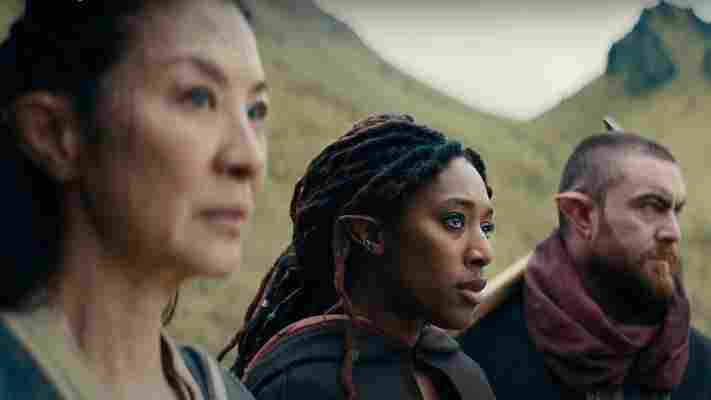
The Witcher: Blood Origin is due to be released sometime in 2022. We know this because the fantasy show's first teaser, which you can watch below, revealed that Blood Origin would land on Netflix this year.
There's no official launch date for the TV series yet, but we imagine it won't be a lengthy wait. There's bound to be some post-production elements left to finish up on (Blood Origin only finished filming in November 2021), so don't expect it to arrive in the first half of 2022.
If we had to guess, we think that The Witcher: Blood Origin will release in summer 2022. That gives The Witcher's sizable crew enough time (hopefully without crunching) to finish up adding VFX to every episode, editing each entry, adding in its score and conducting any last-minute re-recorded audio if there are any hitches with specific scenes. Once we learn more about an official release date, we'll update this section.
The Witcher: Blood Origin trailer: check out the first teaser
The first teaser for The Witcher: Blood Origin has landed online on December 20.
Blood Origin's first teaser is full of sweeping shots of multiple vistas, lots of action, and does an intriguing job of introducing a batch of new characters who'll take center stage in the series. That includes Michelle Yeoh's Scian, Sophia Brown's Éile, and Laurence O'Fuarain's Fjall – Blood Origin's leading trio who'll have vital roles to play in the show's plot and the Continent's future.
The one-minute long teaser's song drops a major hint at what's to come in the series, too. 'Burn', a 2013 single from UK singer-songwriter Ellie Goulding, feels rather apt for a show that'll show the downfall of Elven civilization due to the Conjunction of the Spheres. But we'll talk more about Blood Origin's story later.
Netflix also released a behind-the-scenes look at the making of Blood Origin as part of its 2021 Tudum fan event. You can check that out below:
The Witcher: Blood Origin cast: who is portraying who?
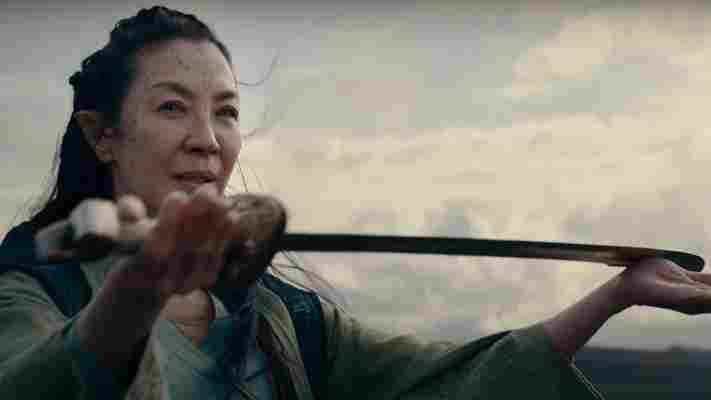
The Witcher: Blood Origin cast consists of 14 characters so far, with Yeoh, Brown and O'Fuarain playing the show's leads:
While Yeoh is the biggest name attached to Blood Origin, it's Brown's Éile who will be the series' protagonist. Per a November 2021 Entertainment Weekly article, Éile is a warrior of the Queen's guard who leaves her post to become a traveling musician. Judging by the footage we've seen so far, however, Éile will be roped back into the life she left behind.
The role of Éile initially went to Jodie Turner-Smith (Queen and Slim, Without Remorse ). But, due to a scheduling conflict, Turner-Smith was replaced by Brown (Giri/Haji) in July 2021.
As for Yeoh ( Star Trek: Discovery , Shang-Chi ), her character Scían is the last of a tribe of Elven nomads. Scían is described (per Deadline ) as “the very last of her nomadic tribe of sword-elves. No one can come close to her artistry with the blade, and no one carries as much loss within their heart. When a chance presents itself to retrieve a stolen sacred sword, taken from her fallen tribe by nefarious means, she launches herself into a deadly quest that will change the outcome of the Continent.”
Finally, O'Fuarain (Vikings, Game of Thrones ) will portray Fjall, whose character is described by Variety as being "born into a clan of warriors sworn to protect a King, Fjall carries a deep scar within, the death of a loved one who fell in battle trying to save him. A scar that won’t let him settle, or make peace with himself or the world around him. In his quest for redemption, Fjall will find himself fighting beside the most unlikely of allies as he carves a path of vengeance across a continent in turmoil."
It's unclear how this trio will join forces in The Witcher: Blood Origin, but we imagine it'll have something to do with the Conjunction of the Spheres. In Sapkowski's novels, this cataclysmic, multiversal event (that took place 1500 years before The Witcher's main events) caused every world and reality to collide with one another, leading to a situation where humans, elves and monsters all exist in the same dimension.
The Conjunction of the Spheres had effects that would last hundreds of years in this universe, and is responsible for the rich and diverse make-up of the world – but also the danger, chaos, and uncertainty that prevails throughout it. So important is the Conjunction to the entire world of The Witcher, it harbors enormous potential for storytelling and framing the entire universe.

Given what plays out as a result of the Conjunction, we suspect that the series' main characters will need to band together when their missions align. Of course, they could be thrown together by circumstance but, given The Witcher franchise's penchant for fate as a theme, we think it'll be something bigger than these characters solely meeting by chance.
But they aren't the only characters in Blood Origin. Interestingly, Jacob Collins-Levy (The White Princess) has been cast as Eredin, an elven cavalry commander who led the Wild Hunt. With The Witcher season 2 finally introducing the Wild Hunt to audiences, it'll be intriguing to see what elements of Eredin's backstory are included in Blood Origin, and how it leads into The Witcher. The Witcher fansite Redanian Intelligence previously reported (in May 2021) on Eredin appearing in Blood Origin. Expect him to become the series' main villain as it progresses.
There are plenty of original characters set to debut in Blood Origin, too. Lenny Henry (Doctor Who) will appear as someone called Chief Druid Balor, while Dylan Moran (Black Books) has been cast as Uthrok One-Nut. Other supporting cast members include Mirren Mack (The Nest) as Princess Merwyn, Nathaniel Curtis (It's a Sin) as Brían, Lizzie Annis (Night Growler) as Zacaré, and Huw Novelli (The Snow Spider) as Callan "Brother Death".
Meanwhile, Francesca Mills (Harlots) will play Meldorf, Amy Murray (in her first major acting role) has been cast as Fenrik, Zach Wyatt (Karen Pirie) will portray Syndril and Aidan O'Callaghan (The Rook) will play Kareg.
It's unknown which of these characters will be on the side of good or evil. But, based on a very brief glimpse shot of six characters preparing for battle, it seems like Mack's Merwyn, Wyatt's Syndril and Novelli's Callan will join forces with Scían, Éile and Fjall for some reason.
Finally, it's possible that we may see Jacob Batey's Jaskier make an unexpected appearance in Blood Origin. Per Redanian Intelligence , everyone's favorite bard will play the role of narrator, revealing what transpired during Blood Origin's events.
Another Redanian Intelligence report suggests that he'll recount what plays out ahead of, and during, the Conjunction of the Spheres. However, Jaskier will be interrupted by an elf who'll tell him he's got his story wrong. Regardless of how or where Jaskier shows up, expect it to be in a cameo capacity only.
The Witcher: Blood Origin plot: what's the story about?
The Witcher: Blood Origin is set 1200 years, before the events of The Witcher, during the universe-altering Conjunction of the Spheres. Expect an emphasis on the ancient Elven society, tensions between races as they are introduced to each other, and the appearance – and disappearance – of the world due to the Conjunction. So there'll be no happy endings, based on what we've seen in The Witcher's first two seasons.
Little else is currently known about the show's overarching plot, but we've been given plenty of teases as to what to expect from The Witcher: Blood Origin.
For one, we'll get to see the origins of the Witchers, humans who have undergone rigorous training and magical experimentation to turn them into the vicious monster hunters we know them to be. Geralt and Vesemir are the most famous Witchers, but we should get a glimpse of who becomes the very first, prototype Witcher as part of Blood Origin's plot.
According to The Witcher's showrunner Lauren Schmidt Hissrich, showing the creation of the first Witcher is a pivotal plot point in Blood Origin due to the Conjunction of the Spheres. Speaking to Digital Spy , Hissrich said: "When we're coming up with spin-off ideas, or how we want to extend this universe, I always go back to the books, and try to find things that are either hinted at, or mentioned, or that we don't have the time to explore in the main series, or that Sapkowski didn’t explore fully in the books.
"The Conjunction of the Spheres is one of those things. And I just wanted to understand: what was the world before the Conjunction? How did it change? Because all of these spheres came together. And how did that begin to set up our world now?"
So expect the Conjunction and the Witchers' creation to form a large part of Blood Origin's story. But that's not the only element that the series will focus on. After all, based on the appearances and backstories of the show's leading trio, the Continent's elven civilization are the dominant species before the Conjunction occurs.
For Blood Origin showrunner Declan de Barra, exploring the elves' pre-colonized world also plays an integral role in proceedings, telling Entertainment Weekly (EW): "I just was fascinated with the idea of what a pre-colonized world would look like for the elves.
"When you look at our own history, societies that had been at their height, like the Roman Empire or the Mayan Empire, that'd be right before the fall and then we're in dark ages again. That fascinated me to wonder what that world could have been: what society would have been like and what elves wanted. That's what we're going to explore here."
Elaborating further on why a pre-colonized world seemed like the right fit for Blood Origin, de Barra added (per EW ): "It [the world before the Conjunction] is very vague in the books as to what happened. I got out a whiteboard and sketched out this plan of what I thought: what elves wanted in this world and what the society was like pre-colonization. That kind of stuck."
Netflix's official synopsis also provides some clues on how Blood Origin will explore the origins of Princess Cirilla's bloodline and powers, which we've seen in The Witcher seasons 1 and 2.
The synopsis reads: "Set in an elven world 1200 years before the world of The Witcher, Blood Origin will tell a story lost to time – the origin of the very first Witcher, and the events that lead to the pivotal ‘conjunction of the spheres', when the worlds of monsters, men, and elves merged to become one."
Blood Origin is surely a nod to Elder Blood, aka the bloodline that Ciri belongs to, and that distinguishes her as special and powerful – dangerously so. The Elder Blood began with elven mages and was originally meant to be kept solely within the Elven race. This did not occur as one prominent carrier strayed from the elven line to begin a relationship with a human. Given this relates to such an important, and now established character in Ciri, it'll be incredibly interesting to see if The Witcher: Blood Origin shows us how the bloodline began.
Additionally, the Elven/human mixing of the Elder Bloodline happened after the Conjunction of the Spheres, and the Witcher order came well after the Conjunction, too, so there's plenty of leaps that will need to be made to compress it all into the six episodes.
Regardless of Blood Origin's actual story, the show will "surprise" fans of the The Witcher TV series as well as fans of the books, according to Hissrich. Speaking exclusively to TechRadar at The Witcher season 2's junket, Hissrich said: "I think one of the things that’s going to surprise viewers is how it looks. We had a very clear stance on ‘it can’t just be another branch of our medieval fantasy.’
"So how do we reinvent what this world looks like? But I think what’s really going to surprise people is that it doesn’t look older than The Witcher. In fact, in some ways, it looks more modern. Because we get to talk about what elven civilization was before humans came before the Conjunction of the Spheres. So I think it’s going to be really fun and surprising for fans."
The Witcher: Blood Origin future: will there be a sequel?
It's unlikely, but never say never. The Witcher: Blood Origin is being billed as a limited series, which fleshes out the live-action universe's world and allows fans to go deeper into it outside of Sapkowski's novels.
De Barra, though, has suggested that a second season could become a thing if the show is a success, simply telling EW that it's "up to the fans" if more than six episodes are to be made.
If The Witcher: Blood Origin's story has a satisfying conclusion at the end of its initial six-episode run, there's no real reason for another batch of episodes. There's plenty of Witcher content coming to Netflix in the future, including The Witcher season 3, another animated movie and a child-friendly spin-off show.
That's more than enough Witcher projects for the franchise's creative team to be busy with for now but, clearly, Blood Origin's future will depend on whether audiences want to see more of this version of the world before the Conjunction truly takes effect.